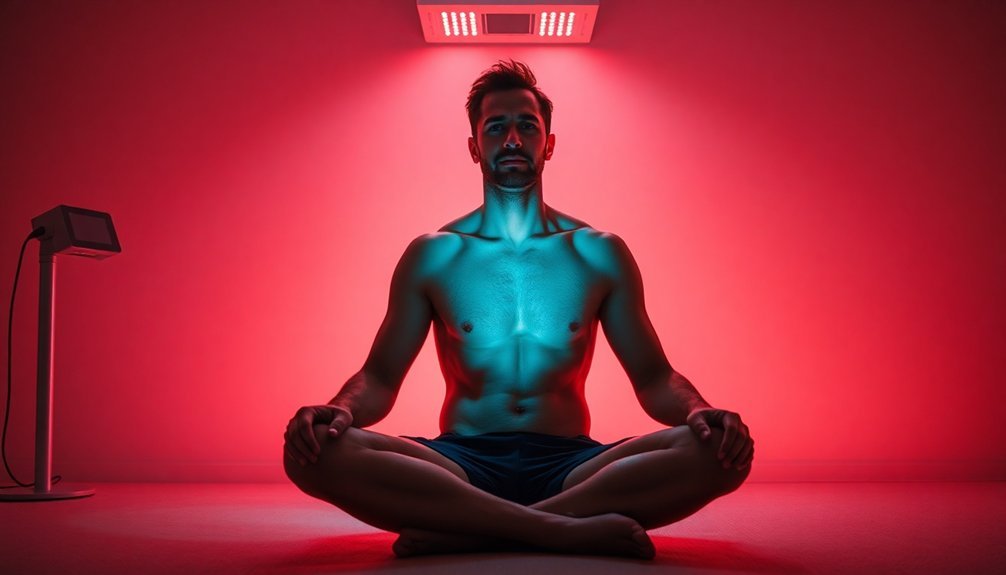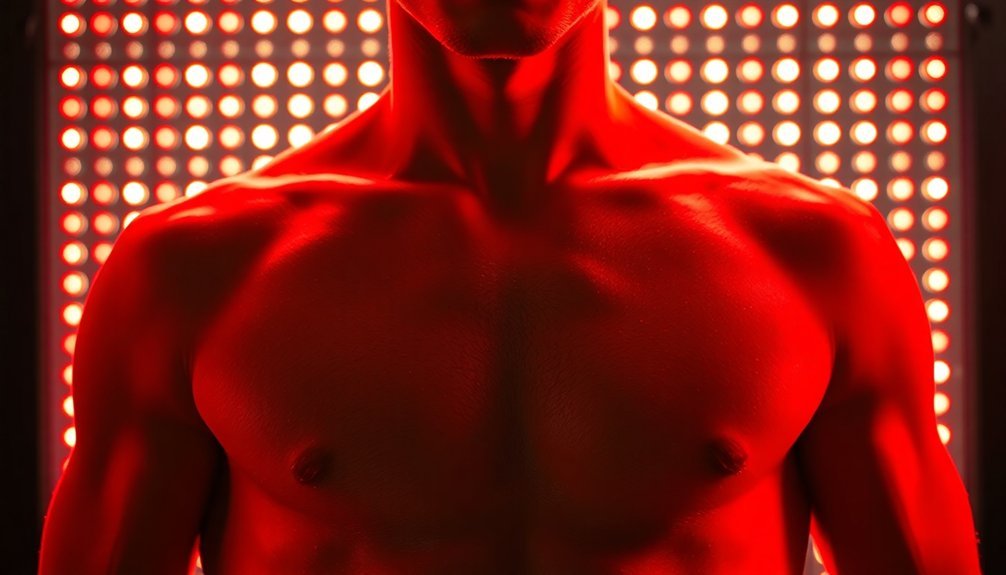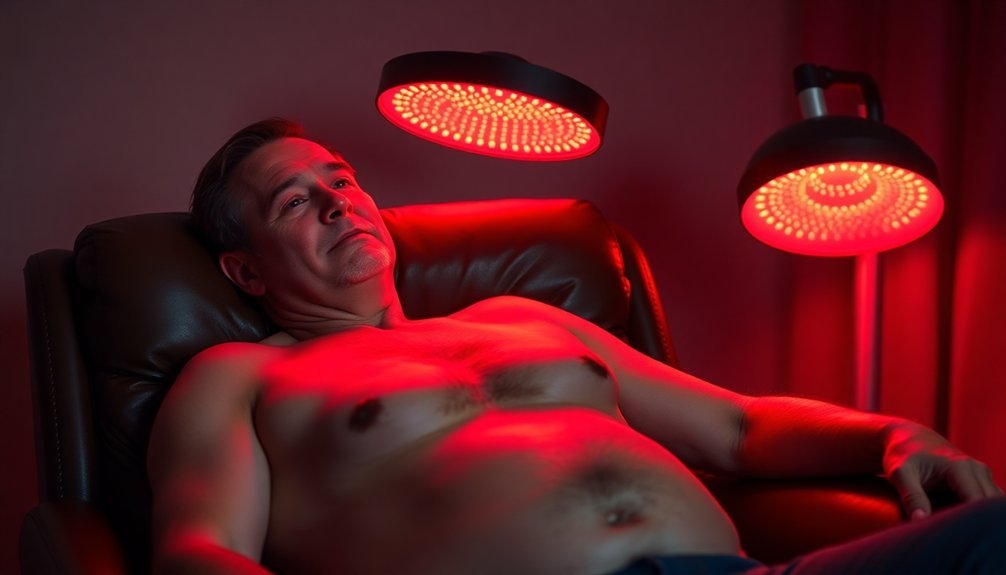Red and near-infrared light therapy can naturally boost your testosterone levels through several key mechanisms. When specific wavelengths penetrate your tissues, they stimulate photoreceptor proteins in the testes and enhance ATP production in Leydig cells – both essential for hormone production. You'll benefit from improved cellular energy and reduced oxidative stress, which supports overall hormonal health. The therapy also helps regulate your HPA axis for better stress response and hormone balance. It's a non-invasive approach that works with your body's natural processes, and there's much more to discover about its hormone-optimizing potential.
Scientific Mechanisms Behind Light Therapy

Light waves act like tiny cellular mechanics, influencing your body at its most fundamental level. When red and near-infrared light penetrates your tissues, it triggers a process called photobiomodulation, which directly affects your cells' powerhouses – the mitochondria. This interaction activates cytochrome c oxidase, a vital enzyme that boosts your ATP production and cellular energy.
You'll find that light therapy's impact goes beyond just energy production. It helps regulate your reactive oxygen species (ROS) levels, reducing harmful oxidative stress that can interfere with hormone production. Research shows that bright light exposure in the morning can increase cortisol levels by more than 50%.
The therapy also influences your hypothalamic-pituitary-adrenal (HPA) axis, which controls your body's stress response and hormone balance.
The wavelengths used in red light therapy can reach deep into your tissues, targeting specific endocrine glands responsible for hormone production. As the light interacts with your cells, it initiates changes in gene expression and activates biological pathways that support hormonal health.
This cellular-level interaction creates an ideal environment for your endocrine system to function efficiently, helping maintain stable hormone levels and supporting overall metabolic balance.
Boosting Natural Testosterone Production
Maximizing your body's natural testosterone production starts with understanding the powerful role of red and near-infrared light therapy. When you expose your body to wavelengths between 660-850 nm, you're activating photoreceptor proteins in your testes that directly stimulate testosterone production. This process enhances ATP production in your Leydig cells, which are vital for hormone secretion.
To boost your testosterone naturally, you'll want to follow specific protocols. Start with 10-20 minute sessions, three to four times weekly. Unlike testosterone replacement therapy, this method won't cause unwanted side effects while still delivering impressive results. After age 30, men experience a 1-2% yearly decline in testosterone production.
You're not just improving hormone levels; you're enhancing overall cellular function and sexual satisfaction.
You can amplify these benefits by combining light therapy with proven lifestyle choices. Include regular weightlifting and HIIT workouts in your routine, prioritize quality sleep, and maintain an active sex life.
It's also important to minimize your exposure to hormone-disrupting chemicals like BPA and parabens. When you follow these protocols consistently, you're supporting your body's natural testosterone production while avoiding the risks associated with synthetic hormone treatments.
Red Light Health Benefits

Understanding the thorough benefits of red light therapy reveals its remarkable impact beyond hormone optimization. Through photobiomodulation, you'll experience enhanced cellular function as the therapy stimulates ATP production, providing your cells with the energy they need for peak performance.
You'll notice significant improvements in multiple areas of your health. The therapy reduces inflammation and oxidative stress throughout your body while accelerating muscle recovery and wound healing. The therapy excels at promoting tissue repair through increased ATP production in damaged areas.
When it comes to sexual health, red light therapy doesn't just boost testosterone – it specifically targets Leydig cells and stimulates photoreceptor proteins in your testes, naturally enhancing your hormonal production and sexual satisfaction.
The non-invasive nature of FDA-approved red light therapy makes it an accessible option for at-home use. You'll benefit from both visible red light and near-infrared wavelengths that penetrate deep into your tissues, promoting healing and regeneration.
Beyond the physical benefits, you'll experience improved cognitive function, enhanced mood, and anti-aging effects. The therapy's ability to reduce pain and support brain function demonstrates its extensive approach to whole-body wellness, making it a powerful tool for optimizing your overall health.
Clinical Research Supporting Light Treatment
Compelling research has come to light supporting the effectiveness of light therapy for male hormone enhancement. A groundbreaking 2016 Italian study showed men receiving morning light therapy experienced a significant boost in testosterone levels, jumping from 2.1 ng/ml to 3.6 ng/ml over just two weeks. Studies have confirmed that these treatments stimulate ATP production in cells, leading to enhanced testosterone production.
| Research Aspect | Key Finding | Clinical Impact |
|---|---|---|
| Hormone Change | 71% testosterone increase | Improved libido |
| Treatment Protocol | 30-min morning sessions | Easy implementation |
| Control Group | No significant changes | Validates effectiveness |
The science behind these results centers on light's interaction with your pineal gland. When you expose yourself to specific wavelengths of light, it inhibits melatonin production and reduces prolactin levels – both of which can suppress testosterone. The study's controlled environment demonstrated that you'll get the best results using a UV-filtered light box for 30 minutes each morning. While these findings are promising, you should know that researchers are still investigating the ideal duration and intensity of light exposure. They're also exploring how you might combine this therapy with other treatments to maximize its hormone-boosting effects.
Safe Home Application Methods

Several proven methods exist for safely applying wavelength therapy at home to boost testosterone levels. You'll want to focus on devices that emit visible red light (600-700nm) or near-infrared (850nm) wavelengths, as these specific ranges have shown the most promising results for testosterone production.
To maximize benefits, you should limit your sessions to 2-5 minutes daily or at least three times weekly. When applying the therapy, make certain of direct exposure while avoiding overheating.
It's essential to use LED or laser devices specifically designed for red light therapy, like the critical series products, rather than heat lamps or incandescent bulbs that can cause damage.
You'll enhance your results by combining light therapy with lifestyle modifications. Focus on getting adequate sleep, maintaining a nutrient-rich diet with zinc and DHEA supplements, and engaging in regular exercise.
Don't forget to take breaks between sessions to prevent overheating, and separate multiple daily sessions by several hours. Stay away from blue/UV light exposure and environmental toxins like BPA, as these can counteract the therapy's benefits and potentially harm your hormone production.
Frequently Asked Questions
How Long Does It Take to See Noticeable Results From Wavelength Therapy?
You'll typically notice initial changes in mood and energy within 3-6 weeks. More significant physical results, like improved muscle mass and strength, become visible between 3-6 months with continued wavelength therapy sessions.
Can Wavelength Therapy Interact Negatively With Testosterone Replacement Medications?
You'll be glad to know there's no documented negative interaction between wavelength therapy and testosterone replacement medications. However, you should always inform your healthcare provider about any treatments you're currently using.
What Time of Day Is Most Effective for Wavelength Therapy Sessions?
You'll get the best results from wavelength therapy between 6-8 AM when your body's natural hormones peak. If needed, you can add a second session midday for an extra energy boost.
Does Body Fat Percentage Affect the Effectiveness of Wavelength Therapy?
Yes, your body fat percentage substantially impacts wavelength therapy's effectiveness. Higher body fat reduces light penetration into tissues, limiting the therapy's benefits. You'll get better results with lower body fat levels.
Are There Specific Areas of the Body That Respond Better?
Yes, your testicles and groin area respond best to red light therapy since they contain Leydig cells. You'll also see benefits when targeting larger muscle groups and areas with more mitochondria-rich tissue.
In Summary
You've learned how specific wavelengths of light, especially red and near-infrared, can boost your testosterone levels naturally. By incorporating light therapy into your daily routine, you're supporting your body's hormone production through improved cellular function and blood flow. Whether you're using professional devices or at-home tools, you'll get the best results by staying consistent and following proper exposure guidelines for maximum hormonal benefits.





Leave a Reply